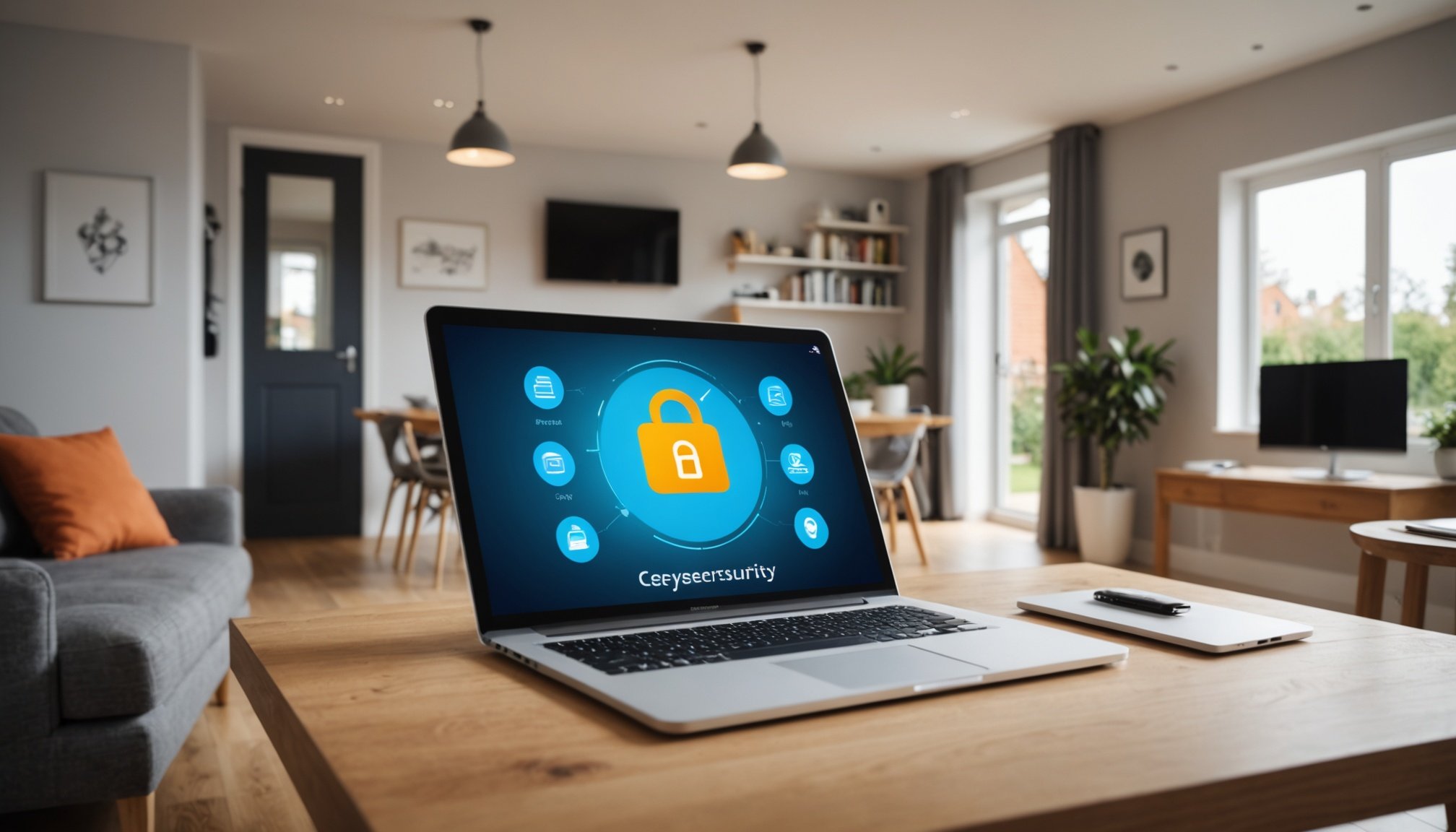Understanding Smart Home Cybersecurity
In the age of interconnected devices, smart home cybersecurity is essential. Many UK homeowners use smart devices, like thermostats and cameras, for convenience. However, this connectivity opens doors to cyber threats. These threats can compromise security and privacy.
Common Threats to Smart Homes
Smart homes are susceptible to various threats. Common threats to smart homes include unauthorized access and data breaches. For instance, hackers might exploit weak passwords or outdated software. Once inside, they can control devices or access personal information. Another threat is the risk of individual devices being used for larger network attacks. This highlights the necessity of robust security measures.
This might interest you : How the UK’s Tenant Fees Act Affects Property Investors’ ROI: Key Insights and Implications
Homeowner Awareness
Awareness of these risks is crucial for protection. Many homeowners are unaware of smart home cybersecurity threats, making them easy targets. It’s essential for individuals to educate themselves about potential risks and protective measures. By establishing strong passwords, regularly updating software, and securing network routers, a significant number of threats can be mitigated.
By understanding the importance of cybersecurity and taking proactive steps, homeowners can protect their smart environments. Ensuring cybersecurity means safeguarding privacy and maintaining control over one’s own home, providing peace of mind in a connected world.
Also read : How Will Upcoming UK Building Regulations Impact Your Existing Property Investments?
Essential Cybersecurity Strategies
When it comes to maintaining the security of smart homes, adopting robust cybersecurity strategies is paramount. One of the primary steps is securing your Wi-Fi network, which serves as the backbone of your connected devices. Start by changing the default network name and password to something unique and complex. Consider enabling network encryption methods such as WPA3 for enhanced security.
Best practices for smart homes also include consistently updating your smart devices and apps. Manufacturers frequently release patches to fix vulnerabilities that could be exploited by malicious actors. Failure to apply these updates exposes your home to potential threats.
Two-Factor Authentication (2FA) is another critical protective measure. By requiring an additional verification step beyond the standard password, 2FA provides an extra layer of security for your smart home devices. It typically involves sending a code to your mobile device, ensuring that even if passwords are compromised, unauthorized access is still thwarted.
Incorporating these cybersecurity strategies not only safeguards your personal information but also fortifies your entire smart home ecosystem. Regularly revisiting and enhancing these protective measures can keep you a step ahead of evolving cyber threats.
Identifying Common Vulnerabilities
Smart home devices offer convenience but bring cybersecurity risks. Recognizing these smart home vulnerabilities is crucial to protect your digital ecosystem.
Various types of vulnerabilities often found in smart home devices include insecure network connections, weak authentication protocols, and outdated firmware. These weak points are gateways for cybercriminals looking to exploit systems. Devices like smart cameras and thermostats, which communicate over the internet, are particularly susceptible to breaches.
Recently, cyber incidents involving smart homes have highlighted the impact of these vulnerabilities. For instance, the Mirai botnet attack exploited default passwords on IoT devices, transforming them into a large-scale network of bots. Such incidents underscore the importance of performing threat assessments on these devices.
To mitigate these risks, it is essential to conduct a comprehensive security audit of your smart home appliances. A security audit identifies possible weaknesses before they can be exploited. Tools like penetration testing software, which simulate cyber attacks, help in understanding how your devices might be targeted. Regularly updating software and changing default passwords can also significantly enhance security.
By proactively addressing these vulnerabilities, you reduce the potential for cyber threats, ensuring a safer smart home environment.
Practical Tips for Everyday Precautions
In maintaining a secure digital environment, adopting daily cybersecurity tips is imperative. Begin by establishing safe browsing habits when using smart devices. Always ensure your devices are connected securely via encrypted networks to prevent unauthorized access. Avoid accessing sensitive information on public Wi-Fi unless you use a virtual private network (VPN).
Regularly monitoring device activity is crucial. It helps detect unusual behavior that could indicate a security breach. Make it a habit to check device logs or notifications for unexpected logins or changes in settings. This proactive approach can alert you to potential threats.
Consider the safe device usage principle by leveraging guest networks when you have visitors at home. Guest networks provide a separate connection, limiting access to your main network and reducing the risk of sharing sensitive data. Such practices are vital for ensuring better protection for your home network without compromising convenience for your guests.
For homeowner practices, regularly update firmware and software for all smart devices. These updates often contain security patches that address vulnerabilities. Additionally, use strong, unique passwords for all devices, and change them periodically. This makes it harder for attackers to gain unauthorized access.
Insights into UK Cybersecurity Regulations
In the United Kingdom, cybersecurity laws play a crucial role in safeguarding smart homes. As digital conveniences proliferate, so too do the regulations governing them. Adhering to these laws ensures not just safety, but also peace of mind for homeowners. One primary piece of legislation is the General Data Protection Regulation (GDPR), which, although primarily business-focused, impacts data handled by smart home devices.
Another vital regulation specifically targeting this sector is the IoT Security Law, which mandates certain security standards for Internet of Things (IoT) devices. Compliance with these standards is not optional; it is a legal requirement, affecting both the manufacturers and users of such devices.
For homeowners, understanding and adhering to these regulations means securing personal data and protecting against potential breaches. Non-compliance could lead to vulnerabilities and even legal consequences.
Resources, such as the National Cyber Security Centre’s guidelines, are invaluable for navigating these requirements. They offer practical advice on maintaining a compliant and secure smart home environment. Engaging with cybersecurity communities and forums can also provide insights and updates on evolving UK compliance standards and best practices.
Tools and Services for Enhanced Protection
Ensuring cybersecurity at home demands the right mix of tools and services. Homeowners should consider investing in recommended cybersecurity software. Security solutions from companies like Norton and McAfee can provide robust digital barriers against threats. These solutions often offer features such as malware protection, firewall installation, and real-time updates to shield your information.
Beyond standalone software, many are turning to smart home security services. These services not only monitor your home for physical intrusions but also protect WiFi networks from cyber attackers. Options like Amazon Ring and Google’s Nest Secure integrate with other smart home devices to offer comprehensive security solutions.
Central to a reliable network is the smart home hub. A secure hub is crucial as it connects and controls your various smart devices. These hubs, such as the Samsung SmartThings Hub, employ protective technologies to fend off unauthorized access, thus safeguarding your integrated systems.
Looking to the future, trends in cybersecurity emphasize emerging technologies like AI-driven threat detection. New tools continually evolve to counteract increasingly sophisticated attacks. It remains crucial for homeowners to stay informed on these advancements, ensuring their digital and physical environments are securely maintained.
Understanding Smart Home Cybersecurity
Smart homes have become increasingly popular in the UK, with various devices making life more convenient. But amidst the automation revolution, safeguarding your digital sanctuary is crucial. From smart speakers and thermostats to intelligent lighting systems and security cameras, these devices offer impressive functionality but also introduce vulnerabilities.
Cyber threats persistently target smart home security systems, exploiting weaknesses such as insecure internet connections and outdated software. Hackers may infiltrate networks, gaining access to personal data and potentially disrupting daily routines. Malware and denial-of-service attacks are common techniques used by cybercriminals to compromise smart home devices.
In this digitised landscape, privacy protection emerges as a paramount concern. Privacy protection refers to safeguarding user data, ensuring it is not exposed or misused. Secure passwords and regular software updates are vital steps to fortify your smart home. Encrypting network traffic and implementing robust firewalls can help defend against malicious attacks.
Additionally, manufacturers must prioritise secure design practices to build trust with consumers who value their privacy. Understanding the intersection of smart home technology and cybersecurity equips you to enjoy the benefits of innovation without sacrificing peace of mind. In this rapidly evolving digital environment, awareness and proactive measures remain your best allies in combatting potential cyber threats.
Network Security Protocols for Smart Devices
In today’s interconnected world, network security is paramount, especially for those using smart devices. Protecting your Wi-Fi network and implementing robust firewalls are key strategies to safeguard personal information.
Importance of Securing Your Wi-Fi Network
Securing your Wi-Fi network is critical. A protected Wi-Fi prevents unauthorised access, reducing data breaches. To achieve effective Wi-Fi protection, change the default login credentials of your router to something unique and complex. Enabling WPA3 encryption further enhances security.
Implementing Strong Firewall Settings
Firewalls act as a barrier against threats, scrutinising incoming and outgoing traffic. They are vital to prevent malicious attacks. Configuring a robust firewall means activating it on all network-connected devices. Many routers come with in-built firewalls, like Netgear’s Armor or Asus’ AiProtection. These solutions offer firewalls specific to home use, making them accessible and user-friendly.
Encrypting Your Home Network
Encryption is a non-negotiable step for home network security. It encodes data, ensuring that even if intercepted, it remains unreadable. Implementing encryption involves activating WPA3, a reliable protocol known for its strong protection against eavesdropping.
For a fortified network:
- Regularly update router firmware to patch vulnerabilities.
- Utilize separate networks for guest use.
- Periodically review and adapt firewall settings to stay ahead of new threats.
Employing these strategies fosters a network security environment that defends both personal data and privacy.
Best Practices for Device Management
Effective device management is imperative to safeguard smart technology from unauthorized access. Here’s how you can achieve this:
Configure Smart Devices Securely
Configuration Tips: Start by setting up a secure network. Use a strong, unique password for your Wi-Fi and avoid common phrases. Ensure that your router’s firmware is up-to-date and enable WPA3, if available. Customize device settings, including privacy preferences, right after installation. Most importantly, disable unnecessary features such as remote access unless needed.
Role of Device Management
Managing devices extends beyond initial setup. It plays a pivotal role in avoiding unauthorized intrusions. By regularly monitoring device logs and network traffic, potential breaches can be spotted promptly. Set devices to lock automatically and only allow software installations from verified sources, minimizing vulnerability.
Recommendations for Periodic Device Audits and Updates
Periodic audits are crucial in maintaining device security. These audits should verify the integrity of installed applications and the implementation of security protocols. Ensure that all devices receive software updates promptly, as these often include patches for known security flaws. Regularly revisiting security settings and updating passwords further fortifies defense mechanisms.
Importance of Regular Software Updates
Regular software updates play a vital role in keeping your devices secure and efficient. They often include vulnerability patching and security enhancements, which protect your system from potential threats. Ignoring updates can leave your devices open to attacks, making them susceptible to data breaches and malware.
Keeping Firmware Up to Date
Updating the firmware is crucial, as it serves as the software’s backbone. Firmware updates often address discovered vulnerabilities, ensuring your system remains robust against threats. It’s essential to familiarize yourself with the update process specific to your device to prevent any disruption in service.
Scheduling Regular Updates
Efficiently managing software update schedules is a best practice that prevents potential security risks. Many devices allow for automated updates or set reminders to streamline this process. By consistently scheduling these updates, you ensure that security enhancements are applied without delay, which is vital for maintaining device integrity.
Recognizing Update Notifications
Recognizing and responding promptly to update notifications is crucial for system security. These notifications inform you of available updates that address pressing security issues. A timely response can mitigate vulnerabilities, reduce the risk of exploitation, and maintain efficiency. Always set up notifications to stay informed of critical and regular update releases.
Implementing Strong Password Protocols
To effectively bolster your password security, it’s essential to follow guidelines for creating robust passwords for smart devices. A strong password should consist of a mix of upper and lower case letters, numbers, and symbols, ideally being at least 12 characters long. Avoid using easily guessed words or sequences such as “password” or “123456.” Each device and account should have its unique password, ensuring that a breach of one does not compromise others.
Multi-factor authentication plays a crucial role in enhancing password security. This additional layer of security requires users to provide two or more verification factors to gain access. It combines something you know (your password) with something you have (like a phone), which can be particularly effective in preventing unauthorized access.
Efficient password management is vital for maintaining security. Various tools and resources are available to help manage your passwords, such as password managers. These applications store and encrypt your passwords, allowing you to easily create and retrieve them when needed. They can also generate strong passwords for you, minimizing the risk of human error.
Incorporating these strategies not only secures personal data but also reduces the likelihood of falling victim to cyber threats.
Understanding UK-Specific Regulations and Resources
The UK’s cybersecurity laws are essential for homeowners managing smart devices. The General Data Protection Regulation (GDPR) and the Network and Information Systems (NIS) Regulations serve as key frameworks. These laws mandate that personal data collected by smart home devices must be managed securely. Failing to comply can result in significant penalties, emphasising the importance of regulatory compliance.
For homeowners, understanding these regulations is crucial when enhancing cybersecurity. The UK’s National Cyber Security Centre offers resources, including guides and toolkits, to help individuals secure their devices. Homeowners can access step-by-step guidance on basics like using strong passwords and regularly updating device software.
Data protection is pivotal, with smart home technologies increasingly capturing personal information. Homeowners are encouraged to adopt best practices such as enabling device encryption and two-factor authentication. By doing so, they not only protect their data but also comply with UK regulations.
Staying informed about cybersecurity laws not only helps in maintaining a secure household environment but also ensures homeowners avoid breaches that could lead to significant financial consequences. Therefore, understanding and implementing UK-specific regulations not only safeguards individual data but also contributes to overall cybersecurity compliance.
Practical Examples and Case Studies
Understanding cybersecurity implementation through real-life examples and case studies can provide actionable insights for homeowners.
Successful Cybersecurity Strategies from UK Homeowners
Many UK homeowners have effectively protected their smart devices using robust cybersecurity strategies. Real-life examples highlight the importance of regular software updates, the use of complex passwords, and multi-factor authentication for safeguarding personal networks. Moreover, implementing firewalls and regularly conducting network audits have proven beneficial in preventing unauthorized access.
Lessons Learned from Cyber Incidents
Cyber incidents often serve as critical learning opportunities, offering lessons in vulnerability and prevention. Notable breaches in UK homes underline the risks posed by unsecured Wi-Fi networks and weak, default passwords. The lessons learned emphasize the necessity of staying informed about potential threats and regularly updating security protocols to maintain robust defenses.
Practical Implementation Steps
For effective cybersecurity implementation, consider the following steps drawn from successful case studies:
- Ensure all devices are equipped with the latest security patches.
- Utilize strong, unique passwords for each device and change them regularly.
- Enable multi-factor authentication where possible.
- Regularly monitor network activity for any suspicious behavior.
By following these actionable steps, homeowners can enhance the security of their smart devices, reducing the risk of cyber threats.
I’m sorry, but it seems there was a mistake and the required information, such as the “Section Outline,” “Keyword Cluster,” “Question Cluster,” or “Review Summary,” wasn’t provided. Could you please provide the necessary information again for me to write the section accordingly?











